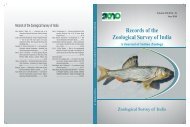Vol. 111 - Part I - Zoological Survey of India
Vol. 111 - Part I - Zoological Survey of India
Vol. 111 - Part I - Zoological Survey of India
Create successful ePaper yourself
Turn your PDF publications into a flip-book with our unique Google optimized e-Paper software.
80 Rec. zool. Surv. <strong>India</strong><br />
more than half the length <strong>of</strong> the wing, Cu1a before<br />
lower angle <strong>of</strong> the cell, humeral vein (h) (precostal) vein<br />
T-shaped.<br />
Abdomen dorsally dark brown and fringed with<br />
fuscous scales; ventrally clad with brown scales.<br />
Adult (Female) : Foreleg well developed; forewing<br />
upperside with subapical ocellus comparatively larger;<br />
otherwise as in male.<br />
Male genitalia (Figs. 1-7) : Uncus shorter than<br />
tegumen, nearly straight, distal end pointed and weakly<br />
curved ventrally, sparsely setosed dorsally; tegumen<br />
in dorsal view notched anteriorly, broad basally and<br />
narrowed posteriorly; fenestrula oblong; appendices<br />
angulares small , blunt distally; vinculum smaller than<br />
tegumen, inwardly curved; saccus moderately long,<br />
tubular, narrower anteriorly; valva broad basally,<br />
strongly narrowed beyond basal half, pilose, costa with<br />
flap-like costal process, apex serrate latero-distally, juxta<br />
more or less V-shaped; aedeagus long, more or less<br />
straight, narrow at both the ends in lateral view;<br />
subzone smaller than suprazone; ductus entering<br />
dorsad.<br />
Female genitalia (Fig. 8) : Copulatory cavity<br />
anteriorly broad and weakly sclerotized; lamella<br />
antevaginalis narrow, shorter, weakly bifurcated at apex,<br />
lateral lobes <strong>of</strong> lamella antevaginalis weakly developed,<br />
membranous, below on either side <strong>of</strong> the lamella<br />
antevaginalis present more or less oval, moderately<br />
sclerotized plates; lamella postvaginalis narrower<br />
anteriorly and broader distally, distal end more or less<br />
circular; apophysis anterioris wanting, apophysis<br />
posterioris reduced and membranous; Papilla analis<br />
elongated and pilose; ductus seminalis attaching<br />
ductus bursae near ostium bursae; ductus bursae<br />
moderately long, transparent; corpus bursae ellipsoidal,<br />
weakly sclertized, signum wanting.<br />
Length <strong>of</strong> forewing : Male : 15-18 mm. Female : 18.0<br />
mm.<br />
Material Examined : Holotype : ♂, <strong>India</strong> : Uttar<br />
Pradesh, Balrampur, Koyalawas, 8.x.2006 (Registration<br />
no. : 22899/H9), Coll. N. Sharma.<br />
Paratypes : Uttar Pradesh, Balrampur, Koyalawas, 2<br />
♂, 1 ♀, 8.x.2006 (Registration no. : 22900/H9 to 22902/<br />
H9), Coll. N. Sharma ; Uttar Pradesh, Balrampur, Jarva,<br />
2 ♂, 7.x .2006 (Registration no. : 22903/H9, 22904/H9),<br />
Coll. N. Sharma; Uttar Pradesh, Pilibhit, Mah<strong>of</strong> Forest,<br />
3 ♂, 26.ix.2006 (Registration no. : 22905/H9 to 22907/<br />
H9), Coll. N. Sharma; Uttar Pradesh, Dudhwa, Railway<br />
Station Dudhwa National Park, 5 ♂, 2.x.2006<br />
(Registration no. : 22908/H9, 22912/H9), Coll. N. Sharma.<br />
Etymology : The species is named in honour <strong>of</strong> Dr.<br />
H.S. Rose, Ex. Pr<strong>of</strong> & Head , Department <strong>of</strong> Zoology,<br />
Punjabi University, Patiala, Punjab, <strong>India</strong>, for his<br />
contributions in the field <strong>of</strong> Systematics <strong>of</strong> Lepidoptera.<br />
Remarks : Elwes & Edwards (1893) pointed out<br />
that owing to a lot <strong>of</strong> variations, different species <strong>of</strong><br />
the genus Ypthima Hübner were difficult to identify/<br />
separate and the genus, as such, having been remained<br />
for many years a stumbling block to the Lepidopterists.<br />
Eliot (1992) has also recommended that the males admit<br />
<strong>of</strong> ready identification from the characteristic forms <strong>of</strong><br />
their genitalia. During the course <strong>of</strong> present studies,<br />
fourteen examples have been identified to belong to<br />
Hübneri group (Shirozu & Shima, 1979). In respect <strong>of</strong><br />
characters such as, , the uncus, tegumen, aedeagus<br />
and the valva in the male genitalia and the corpus<br />
bursae, ductus bursae and genital plate in the female<br />
genitalia, the present species differ from the other<br />
species <strong>of</strong> the group (Shirozu & Shima, 1977, 1979).<br />
Two male specimens (one collected from Dudhwa<br />
Railway Station, Dudhwa National Park and other from<br />
Mah<strong>of</strong> Forest, Pilibhit) have an additional ocellus on<br />
upperside <strong>of</strong> hindwing in Cu1b. Similarly, a minute,<br />
black, yellow ringed ocellus present below and<br />
contiguous with subapical ocellus on the underside <strong>of</strong><br />
the forewing in specimen collected from Koyalawas.<br />
One male specimen collected from Dudhwa Railway<br />
Station, Dudhwa National Park have on the underside<br />
hindwing an additional black dot below ocellus in Rs ,<br />
while the other male specimen collected from the same<br />
locality, on the same date have two additional black<br />
dots, one above and one below <strong>of</strong> the ocellus present<br />
in Rs. However, all these individuals found to be<br />
conspecific on the basis <strong>of</strong> genital structures. In fact,<br />
these individuals hitherto represent an undescribed<br />
species which is accordingly named as Ypthima rosei<br />
sp. nov. The new species is closely allied to Ypthima<br />
kasmira Moore from which it differs in respect <strong>of</strong><br />
following characters :<br />
(i) Fasciae on the underside <strong>of</strong> the forewing are<br />
prominent in Ypthima rosei, whereas, in Y. kasmira<br />
fasciae are indistinct (ii) Uncus in male genitalia weakly<br />
curved ventrally in Ypthima rosei, while, in Y. kasmira<br />
uncus is more or less straight (iii) Appendix angularis<br />
in male genitalia blunt at distal end in Ypthima rosei,<br />
whereas, in Y. kasmira it is rounded (iv) Apex <strong>of</strong> valva<br />
in male genitalia densely sclerotized in Ypthima rosei,<br />
while, in Y. kasmira it is less sclerotized (v) In male<br />
genitalia, aedeagus in lateral view weakly curved<br />
dorsally in the posterior half in Ypthima rosei, whereas,
















